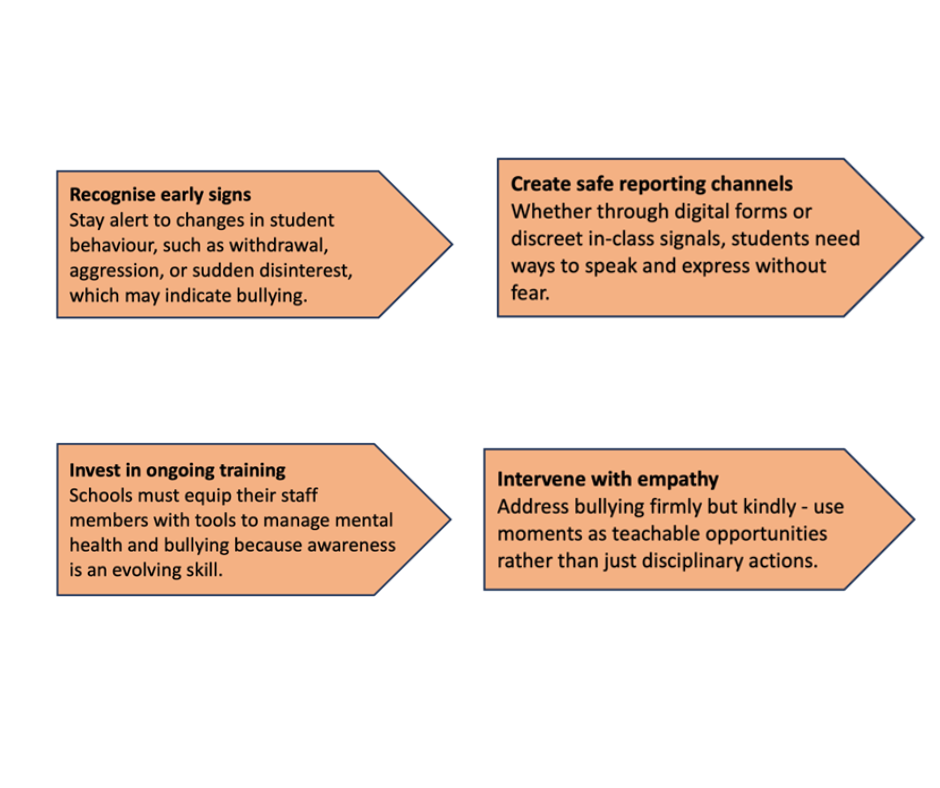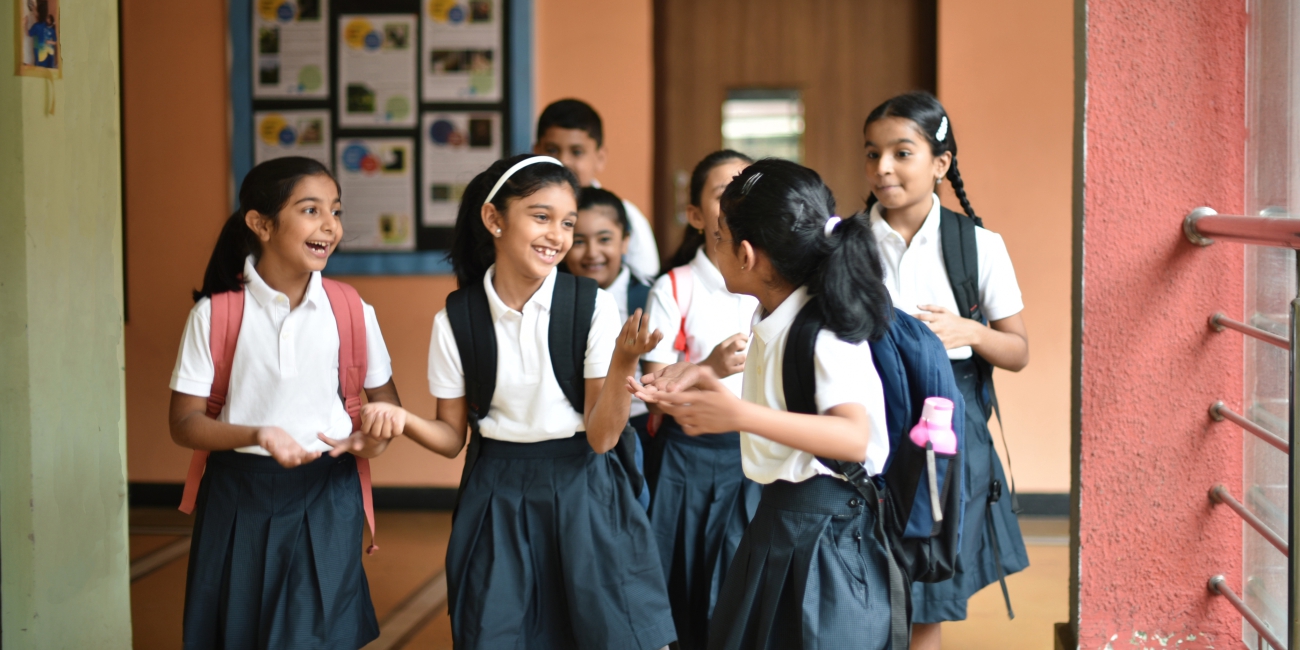![]()
Tackling bullying through empathy, empowerment, and everyday acts of bravery.
| In this article, you’ll discover: • Silence isn’t neutral; it is dangerous • Why bullying often goes unseen, especially online • A school’s role: Going beyond academics • More than lessons: Classroom as the frontline of change • Real stories, real solutions: What is working in India and globally • Building a culture, not just a policy • At home: Noticing what isn’t said • What can you as a parent do to help? • What can schools and teachers do? |
Meet Ravi.
Ravi loved drawing. He would fill pages with animals, superheroes, and wild, wonderful things. But when he brought his sketchbook to school, a group of boys laughed. “Aww, baby art”, they said. Since then, Ravi stopped bringing his notebook. And slowly, he stopped drawing altogether.
Sometimes, bullying doesn’t leave bruises; it erases confidence.
Such moments reveal the many faces of bullying in school, from ragging horrors to caste-based abuse to cyberattacks and physical threats. Sadly, they often end in tragedy, reinforcing why school bullying prevention must be swift, deeply compassionate, and all-encompassing.
Silence isn’t neutral; it is dangerous
When we say silence, we are talking about the silence of classmates who watch but don’t intervene. The silence of children who fear speaking up because they might be the next target. The hush of teachers who miss the signs or dismiss them as harmless teasing. The silence of parents who sense something is wrong but hesitate to ask.
This silence is dangerous. It allows bullying to take root, spread, and stay hidden. The effects of bullying on students continue to affect a child’s self-worth, academic performance, and, most deeply, mental health.
According to the 2023 Bullying Among Indian School-going Children article, the prevalence of bullying is very high in India, at approximately 50% to 60%, which has a bad impact on the students’ health.
Why bullying often goes unseen, especially online
The truth is that bullying isn’t always loud; it can be subtle. It often masquerades as “just memes” or “a joke”, but the harm it causes can spiral rapidly. And today, it is increasingly taking over the digital world. Cyberbullying in schools has skyrocketed post-pandemic, especially with students now using messaging apps and social media.
Online abuse knows no schedule. It follows a child home, lingers 24/7, and can amplify fast. In fact, a cruel meme or message in a WhatsApp or Instagram group can cause viral humiliation overnight.
In Lucknow, a psychiatric unit reported that persistent online trolling led to depression in 15% of youth mental health cases, with instances of severe weight loss and suicidal thoughts among affected students.
A school’s role: Going beyond academics
Schools are ecosystems that shape a child’s emotional compass. Creating a safe school environment means ensuring every student feels seen, secure, and valued.
In July 2018, Delhi’s Education Department launched the Happiness Curriculum (HC) in 1,030 government schools from kindergarten to Grade 8 to focus on the holistic development of all learners.
The Happiness Curriculum curbs bullying by nurturing empathy, mindfulness, and emotional awareness among students. It encourages respectful peer interactions and open dialogue, helping create a school culture where kindness is practised.
More than lessons: Classroom as the frontline of change
The way a teacher behaves creates the emotional mood of the classroom. When teachers laugh at a cruel joke to overlook the subtle exclusions, they unintentionally participate in bullying in schools. But when they pause and ask, “How do you think it made them feel?” they model empathy in action, one of the most effective ways to prevent bullying at school.
Teachers who intervene gently, notice who’s being left out, and use inclusive language to create classrooms that foster trust, safety, and belonging. Teachers’ role in bullying prevention is less about punishment and more about presence. Those who use inclusive language and respond gently to microaggressions create a safe school environment for students.
Real stories, real solutions: What is working in India and globally
Let’s examine some grassroots approaches where both schools and parents can play a crucial role in school preventing bullying.
- SahaaraLine: Social support for teachers:
- A WhatsApp helpline connects educators to experts, offering real‑time support for managing classroom conflicts and bullying incidents.
- Anand Sabha (Happiness Assembly):
- Weekly storytelling, mindfulness, and moral-value sessions in government high schools aim to foster empathy and peer support; launched state-wide in 2025.
- School of Equality:
- Workshops challenging caste and gender norms empowered students to adopt a “school constitution” guaranteeing protection from bullying.
- Finland’s KiVA Program:
- Developed by the University of Turku, the KiVa program systematically tackles bullying by combining classroom lessons, teacher protocols, and peer monitoring.
- Japan’s Anti-Bullying Act (2013):
- The Act mandates early detection and prevention of bullying by assisting children in building interpersonal relationships, improving emotional development, promoting moral education, and fostering healthy peer relationships through hands-on learning.
- ParentCircle:
- An India-based platform that offers articles, tools, and events for mindful parenting and covers bullying, discipline, digital safety, and emotional bonding.
- Vandrevala Foundation:
- A 24/7 mental health helpline offers free emotional support via phone or WhatsApp, which is especially helpful for parents dealing with distressed children.
- Prajnya’s Gender Equality Education:
- Chennai-based initiative that helps parents raise gender-sensitive children and navigate peer aggression.
Building a culture, not just a policy
Anti-bullying strategies for schools shouldn’t be confined to notices on bulletin boards or one-off assemblies. Real change lies in embedding values into the school life curriculum. While India lacks any specific nationwide anti-bullying law, CBSE and several state boards have issued circulars mandating a designated anti-bullying committee in every school, regular awareness workshops, and anonymous reporting systems.
According to Chapter 6 of Cyberbullying and Digital Safety: Applying Global Research to Youth in India, since 2017, all CBSE schools have been guided by the “Guide to Safe and Effective Internet Use”, which establishes digital conduct codes, reporting procedures, and peer education for cyberbullying awareness.
At VIBGYOR Group of Schools, we organise multiple impactful workshops on bullying and cyberbullying, creating a safe school environment. These workshops help students and educators recognise red flags, respond empathetically, and cultivate values that make safety a shared responsibility.
………………………………………………………………………………………………………
At home: Noticing what isn’t said
“Another stomach ache?” Ritu asked her daughter as Meera pushed away her breakfast.
She nodded. “Can I skip school today?”
Lately, Meera has been complaining of stomach aches almost every morning.
“Maybe it is something she ate,” her mother thought, until skipping school became a daily excuse.
She also stopped joining her online classes, claiming the WiFi was acting up. Her appetite had dipped. At night, she tossed and turned. Then came the broken pencil box, the torn sleeve, and the quiet refusal to attend her best friend’s birthday party.
“They called me names…took my stuff”, Meera finally whispered. “I didn’t tell you because I thought you would be mad.”
“I’m not angry”, her mom said, holding her close. “I’m happy that you confided in me.”
Bullying rarely shouts. It hides in silence, subtle changes, and unspoken fears. But parents who are more attentive hear what others miss.
………………………………………………………………………………………………………
What can you as a parent do to help?

These efforts are part of a bigger mission of building empathy to reduce school bullying, starting at home.
What can schools and teachers do?
To actively prevent bullying, schools must foster a culture that goes beyond safety; it is where safety is nurtured.

………………………………………………………………………………………………………
Every school should routinely ask:
- Are students encouraged to report or discouraged by silence?
- Do our staff know how to de-escalate early conflicts?
- Are we reacting only after harm is done or proactively cultivating safety?
These questions are at the heart of how schools can create a safe space for students – not just in structure but in spirit.
………………………………………………………………………………………………………
Bullying in schools affects more than students; it impacts families, educators, and the entire community. Creating a safe school environment means embedding kindness into the culture, where empathy is taught, every voice matters, and respect is lived daily. From classrooms to homes, the path to school bullying prevention begins with awareness, builds through courage, and grows through compassion.
Let’s raise children who are not only smart but strong, thoughtful, and inclusive because the most lasting lessons are learned in how we treat one another.
Please check the recording of VIBGYOR Group of School’s online webinars on Understanding Bullying: Fostering Safer Childhoods sharing valuable insights into recognising and addressing bullying in the early years as well as adolescents.
Link: https://youtu.be/osaaKRcW7fE
Link 2: https://youtu.be/cO38BF7lsPo

